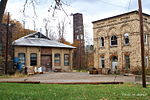Borden Tunnel
American tunnel stubsMaryland building and structure stubsMaryland transportation stubsRail trails in MarylandRailroad tunnels in Maryland ... and 4 more
Tunnels completed in 1911Tunnels in Allegany County, MarylandUnited States rail transportation stubsWestern Maryland Railway tunnels

The Borden Tunnel is a 957-foot long, formerly abandoned, railway tunnel located about 2.5 miles (4 km) north of Frostburg, Maryland. The tunnel is lit with a series of motion activated LED lights powered by a solar panel located just north of the tunnel. It is now part of the Great Allegheny Passage rail trail.The Western Maryland Railway built the tunnel in 1911 for its Connellsville Subdivision. The rail line was abandoned in 1975.
Excerpt from the Wikipedia article Borden Tunnel (License: CC BY-SA 3.0, Authors, Images).Borden Tunnel
Great Allegheny Passage, Southampton Township
Geographical coordinates (GPS) Address External links Nearby Places Show on map
Geographical coordinates (GPS)
| Latitude | Longitude |
|---|---|
| N 39.688611111111 ° | E -78.918888888889 ° |
Address
Borden Tunnel
Great Allegheny Passage
21545 Southampton Township
Maryland, United States
Open on Google Maps


